This page contains affiliate links. We may earn money or products from the companies mentioned in this post through our independently chosen links, which earn us a commission. Learn More
German Shepherds are one of the most recognizable dog breeds in the world. It’s not surprising, though, since they’ve held the number 2 spot of most popular dog breeds for the last five years.
They can be found in every city in every state in the United States. They live in big cities, suburban homes, and rural areas. Their loyalty and devotion to their family make them excellent watchdogs, family companions, and service dogs.
Read also:
Comparison of best dog food for your German Shepherd
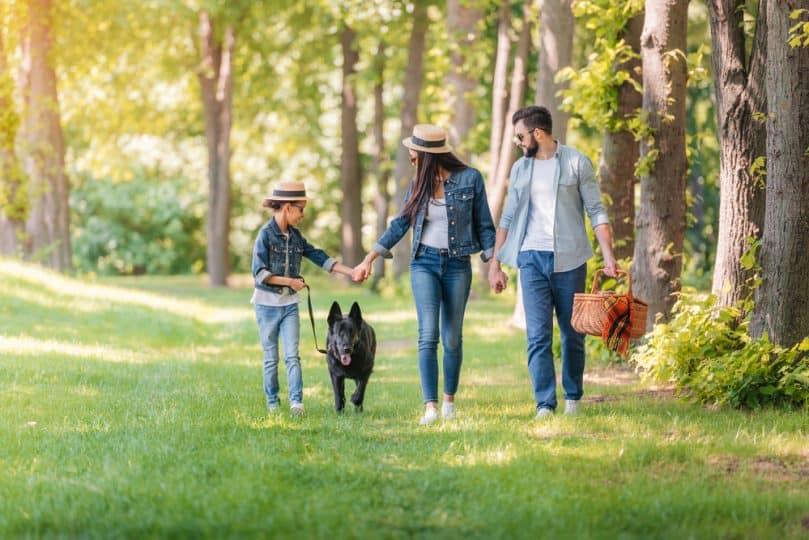
German Shepherd dogs are highly intelligent and trainable. In fact, they may be too smart for their own good, which is why early training and socialization are a must. Failing to socialize and properly train a German Shepherd puppy could make for a nervous, overprotective, and otherwise unbalanced adult dog.
For that reason, we’ve put this guide together on German Shepherd training, so you can start your puppy off right and continue to teach them throughout their life.
Contents & Quick Navigation
At What Age Should You Start Training German Shepherds?
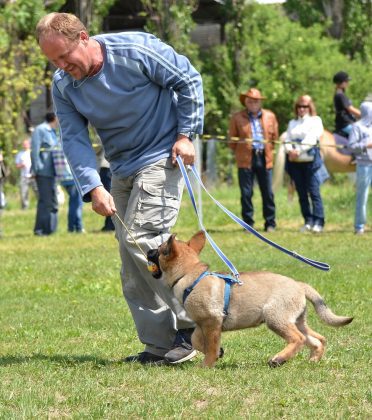
You should begin training your German Shepherd puppy the moment they arrive in your home. Despite popular misconceptions, it’s never too early to start training.
In fact, the longer you wait, the harder it will be to train your pup. If German Shepherd puppies are given the opportunity to form bad habits it will be harder to break them as they get older.
You need to be consistent when training your GSD. Establish the fact that you call the shots when they are still very young. They don’t react well to harsh training methods, nor do they need them. Instead, these beautiful animals should be instructed with a firm but loving hand.
While it’s important to begin training right away, it’s crucial to keep your German Shepherd puppy’s mental and physical development in mind. Set your expectations to match them. For example, it’s unreasonable to expect a 10-week-old puppy to be fully house-trained and responsive to all commands.
If you’re worried that your GSD puppy isn’t reaching various training milestones, check out this general guideline:
By 3 months of age your German Shepherd puppy should be able to:
- Come when called
- Sit on command
- Walk nicely on a leash
- Hold their bladder for 2 – 3 hours
By 6 months of age your German Shepherd puppy should be able to:
- Give paw on command
- Stay or “wait” before taking food on command
- Hold their bladder for 4 – 4.5 hours
By one year of age, your German Shepherd puppy should be able to:
- Hold their bladder for 5 hours (though it’s always better to hire a dog walker if you go out all day)
- Perform a variety of basic commands, walk politely on a leash, and come when called even when there are distractions
This owner has clearly been working hard to train their GSD puppy, as he’s only 3 months old yet already knows a variety of tricks!
Why You Need to Be Alpha and How to Do So
German Shepherd dogs are highly intelligent and social creatures. Their trainability, sense of loyalty, and astounding cleverness make this breed an excellent choice for families who want to compete in a variety of dog sports such as obedience or agility competitions.
This intelligence and sense of dominance mean that they may be difficult to handle for an inexperienced owner. For this reason, German Shepherds, despite their popularity, are not recommended for first-time dog owners or owners who don’t have experience with guardian breeds.
Teaching your German Shepherd that you are the leader of the pack, the alpha, is extremely important. This will ensure that your dog will look to you for guidance rather than taking matters into their own paws. An untrained, dominant German Shepherd is a disaster waiting to happen.
There are a few ways that you can let your German Shepherd pup know who the boss is. While training is extremely effective, there are some even more subtle ways.
- Only feed your dog once you’ve eaten.
- Don’t let your dog go through doorways before you.
- Set boundaries such as not allowing them in the room when you are eating.
- Speak in a firm voice.
- Don’t let disobedience fly. If your puppy ignores a command, get their attention and insist that they listen to you.
How to Do Clicker Training for German Shepherds
Clicker training is a popular reward-based training method. It’s a great option for German Shepherd owners because it’s direct. The dog wants to please their owner, and clicker training is a simple way of letting your dog know what you want so you can instantly reward them once they comply.
If you’re interested in clicker training your dog, the good news is that you only need one thing: a clicker. A clicker is a small plastic device (roughly the size of a thumb drive) with a button makes a distinctive clicking noise when you press it.
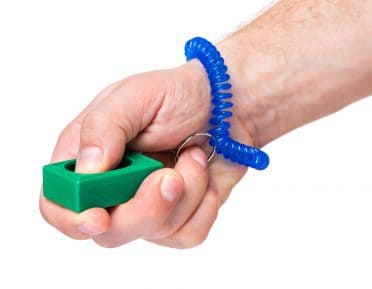
Clicker training is pretty simple. Essentially, you use the clicker to mark the precise moment that your dog does what you’ve asked them to do.
There are tons of different clickers on the market, and they all pretty much do the same thing. The brand and model you choose will be based largely on personal preference. The difference is mostly in the sound: some are loud, while others make a softer clicking noise.
You’ll want to find a clicker that you won’t lose, and that is comfortable to use. Some, such as the Downtown Pet Supply clicker, come with a bracelet so you can wear the clicker around your wrist during training sessions.
Others, such as the Starmark Pro-training clicker, have a keyring and can easily be attached to your house keys, which is particularly useful if you’re using the clicker to help with potty training. It’s also great to be able to train on-the-go.
Whatever clicker you choose, the methodology is much more important than the hardware involved. When clicker training your dog the most important thing is consistency.
Here’s a simplified step-by-step guide to clicker training:
Step 1: Introduce the Clicker
In a calm and quiet environment, sit with your German Shepherd. Have some treats with you, or use their regular food if it’s their meal time. Have a tasty reward in your hand. When they get close, press the button and present the food as the click sounds.
Keep it up, and eventually, your dog will associate the sound of the click with getting a treat. To test this response, allow them to wander off or look away, then click. When they immediately turn to you looking for a treat, you’ll know they made the connection.
Step 2: Make Them Work for It
The next thing you need your dog to do is to realize that they need to do something if they want a treat. Start with something simple, like sitting or coming when called. As soon as they do it correctly, press the button then give them a treat.
Eventually, they’ll learn that you expect them to work for their treats. They’ll start to look to you for direction and wait for your command so they can get their reward.
Step 3: Click More, Reward Less
After several weeks, you should be able to have your German Shepherd perform several tricks before giving a reward. However, it’s important to continue to use the clicker to let them know that they have done correctly and a treat is coming.
If your dog starts to look anxious or frustrated, it may be that you’re asking too much of them between rewards. Go back and reward for every trick for a little while to let them know that they’re doing great.
Something to keep in mind is that each of these training sessions should be 5 – 10 minutes in length. You want to give enough time for your dog to learn something new and repeat that trick several times but don’t want to go so long that they start to get bored.
How to Crate Train a German Shepherd Puppy
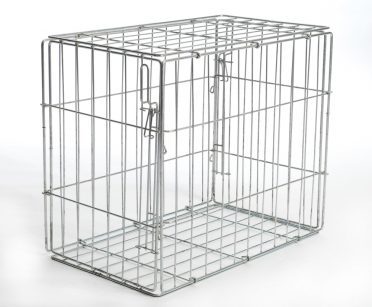
Crate training is the process by which you get your puppy used to spending time in their crate. Whether it is overnight, during the day when you’re at work, or in the evening when you need a little puppy-free time, your puppy’s crate should be their haven.
It’s best to get a crate that can accommodate your full-grown GSD, so you don’t end up having to buy several during their first year of life. The good idea is to buy a crate with a divider, such as the MidWest LifeStages large crate. It measures 48 x 30 x 33 inches, and you can use it to gradually give your puppy more space as they grow.
You want your puppy to associate the crate with positive experiences. If you do it right, your German Shepherd will love its crate even as adults and will likely go there when they need a moment to themselves.
Here’s how to teach your puppy that the crate is a good place to be:
- Never force them inside. If you do so, they will come to associate the crate with something unpleasant. Instead, offer your puppy treats to coax them in.
- Start by closing the door only for a few seconds and then let them out. Gradually increase the amount of time until your pup is happy to be there for 5 to 10 minutes.
- Feed your puppy in their crate. If they eat all of their meals in their crate, they will consider the crate their “special place.” They will also be less likely to go to the toilet in it.
- Never leave your puppy in the crate for too long. Even the most well-trained puppy won’t be able to hold their bladder all day and will be forced to mess in the crate, which will set back their potty training.
Here you can read our complete guide to crate training a puppy.
How to Housebreak a German Shepherd Puppy
It’s important to start house training your German Shepherd puppy as soon as possible! If you’re lucky, your GSD’s breeder may have already begun the house training process before you even take your pup home. But, this isn’t always the case.
Because German Shepherds puppies have tiny bladders, it’s important to be realistic about how long they can last without a potty break. So, follow the hour-per-month rule. If your puppy is one month old, they can hold it for one hour. If they are three months old, they should be able to hold it for three hours etc. (up to 8 months).
Here are some tips to housebreaking a German Shepherd puppy:
- Maintain a consistent feeding and eliminating schedule.
- Always take your puppy outside: first thing in the morning, immediately after eating, after they wake up from naps, and right before bed.
- Take your puppy to the same spot in the yard to go. The scent of their previous eliminations will prompt them to do their business.
- Stay outside with them until they’ve gone.
- Reward your puppy. If you’re clicker training, click as soon as they start to go, then give a treat when they finish and can come to you.
- Never punish a puppy for going inside the house. If you catch them in the act, firmly say “no” and do your best to get them outside to finish up. If you find a mess afterward, do NOT rub their face in it. They may develop a fear of their waste and start eating it to hide it from you.
- Be patient and consistent. It can take between 4 and 6 months to completely housebreak a puppy, so expect accidents along the road.

How to Train Your German Shepherd Puppy Not to Jump
While having your German Shepherd puppy jump up enthusiastically is cute when they are little, the novelty wears off pretty quickly. A 20-pound puppy may be unlikely to knock you over; a 100-pound adult is another story.
Luckily, teaching your pup not to jump isn’t rocket science. It’s a matter of conditioning. The first step in training your German Shepherd pup to keep calm when they greet you is to set the mood: if you are relaxed, your puppy will learn to be relaxed as well.
Here are a few tips:
- Keep greetings low-key. Greeting your puppy enthusiastically and loudly is a great way to encourage them to jump up. Instead, come in the front door quietly and wait a minute or so before saying hello to your pup.
- If your dog jumps on you, ignore them. Resist the urge to pet them. Petting them when they jump up reinforces the negative behavior. Turning away from them when they jump will show them that jumping does not get your attention.
- Only pay attention to your dog when they’re sitting. As soon as you get in the door, tell your dog to “sit,” and only reward them with attention when they’ve done so.
- Be patient. Because your German Shepherd pup is so happy to see you when you walk in the door, it may take them a while to realize that they will only get the attention they want when all four paws are on the floor.
Training German Shepherds Not to Bite or Chew on Things
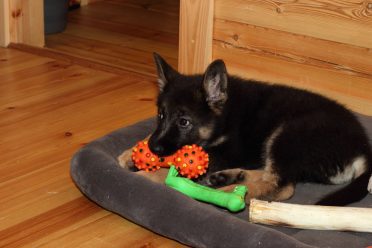
Dogs explore the world through their mouths, and most puppies go through a biting stage. This type of biting is not aggressive, but it still needs to be addressed before they get bigger when a playful bite can become dangerous.
Chewing is another popular puppy past-time. They may do it simply out of boredom, because their teeth are coming in, or as a way to learn about their world. Once again, it’s a natural behavior that should be curbed as early as possible.
Here are some tips for teaching your German Shepherd puppy not to bite or chew on things:
- Yelp or cry when they bite during play. This is what their mother and littermates did to let them know they got too rough, so it’s a very natural way to teach them not to bite you. Let your hand go limp and then ignore them for 30 seconds to send a clear message: if you bite me, I will not play with you.
- Provide toys. You need to provide them with something they’re allowed to sink their teeth into, especially when they’re teething. Have a variety of toys for your puppy to choose from.
- Use an anti-chew spray. Chew Deterrent Spray is just one example of a non-toxic substance that you can put on nearly anything. It has a horrible taste, so one nibble and your puppy won’t go back to chewing on whatever you sprayed.
How to Keep Your Dog from Barking
While German Shepherds communicate primarily through body language, their bark is another way for them to let others know what they’re thinking. It’s unreasonable to expect your German Shepherd never to bark, but you should teach your dog when barking is acceptable.
A GSD is a guardian breed, and he will want to protect his family and his home from any danger. That’s why they bark when someone knocks on the door. But, they may also bark at other dogs, the TV, and other non-threatening stimuli.
What can make this behavior tricky is that you want them to bark to alert you when a stranger or other legitimate danger approaches, but you also want them to stop after you’ve confirmed that the family is not in danger.
The best way to do this is to follow these steps:
Step 1: Reward the Good Behavior
As soon as your dog barks at the stranger walking up to your porch, thank them and tell them they’re good. If you’re using clicker training, give them a click and a treat.
Step 2: Distract Them
When they’re distracted by a treat from whatever they were barking at, quickly command them to lie down. This will put them in a submissive position and gives them something to do other than bark.
If that doesn’t work and you have an excessive barker, then you might need to implement a “shake can.” It’s easy to make by adding some pennies to an empty can. When your dog is out of control, give it a good shake, and the noise will scare them. Then, you can reward the fact that they stopped barking.
It will take some time, but eventually, your German Shepherd will learn that a couple of barks are welcome, but more is not needed.
List of German Shepherd Training Commands
Clicker training can be used to teach your German Shepherd a vast variety of commands. In fact, the options are almost limitless! However, it’s generally best to begin with the basics.
Here are some of the basic commands you can teach your German Shepherd along with some steps you can take to train them using clicker training:
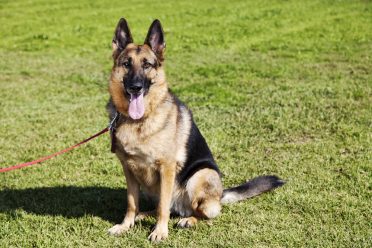
Sit
To teach your dog to sit, you’ll want to gently push down their rear or bring a treat over their head until their butt touches the ground. As soon as they are in the sitting position, click and give them a treat.
Dogs generally learn this command very quickly, so it’s likely that with a few repetitions your German Shepherd will get the idea.
Stay
After your dog knows how to sit, the next step is teaching them to stay. Start with asking your dog to sit. Then, tell them “stay” in a calm voice and put your hand out with your palm facing them. Walk back a few steps. Click and reward your dog if they stay put.
Gradually increase the distance you move away from them. If you move too quickly, your dog may try to follow you, so take it slow and be consistent. If your dog gets up to follow while they’re supposed to be staying, you can try asking them to sit again to help them understand what you’re asking.
Lie down
The easiest way to teach your dog to lie down is to ask them to sit and then lure them into a downward position with a treat. Gradually bring the treat down and towards you until they are lying down. As soon as they lie down, click and give them a treat. You’ll likely need to repeat this exercise multiple times, but they should soon get the hang of it.
Shake
While not particularly useful, “shake” is a fun party trick. Pick up your dog’s paw while saying “paw” or “shake,” click, and then give them a treat. Repeat this action over and over, and your dog will soon be offering you their paw at every chance they get.
Come
To teach your dog to come when they’re called, you may need some help. The easiest way to teach this command is to have someone else restrain your dog while you call them, using “come” as the command.
The other person should release the dog as soon as you give the command and when your German Shepherd arrives at your feet, click and give them a treat.
It can be difficult for a young dog to learn when there are distractions, so it’s especially important to teach this trick in a quiet area where they can focus on you and what you have for them. Once they get it down, you should be able to give this command in any situation.
Here’s a great example of a German Shepherd puppy focusing on her owner to learn a variety of tricks:
Once you get these basic commands down, you can begin to teach your German Shepherd an even wider variety of tricks and commands. Most of these basic commands are not just fun tricks but will help keep your German Shepherd safe and under control.
German Shepherd Commands in German
In case you’re interested in training your GSD in German, here are a few basic commands and pronunciations:
| Command in German | Pronunciation | English Meaning |
| Achtung | Ahk-toong’ | Watch, attention |
| Aus | Ows | Out! Drop It! Let Go! |
| Bleib | Blibe | Stay |
| Bring | Brring | Fetch |
| Fuss | Foos | Heel |
| Hier | Heer | Come |
| Nein | Nine | No |
| Platz | Plots | Down |
| Sitz | Zetz | Sit |
Although it’s a lot of fun to teach your German Shepherd tricks in German, it’s best to start in English. That way, when anyone else needs to ask them to do something, they’ll be able to do so without you being there.
A great way to make this transition is to also teach your dog hand signals. You can use a hand signal along with the command in English and eventually, they’ll respond just to the hand signals.
Then, you can start using the hand signals with German words and eventually, they’ll respond to the German commands alone as well. Because these dogs are highly intelligent, they’ll not only be able to learn each trick with 3 different signals, but they’ll have fun doing it.
Leash Training Tips and Tricks for German Shepherds
Whenever you take your German Shepherd out of the house, you should put them on a leash. In many places, it’s illegal to have a dog off-leash when outside the home. This is because many dogs have trouble behaving themselves when left to their own devices.
Harnesses are a safer alternative to collars. If your dog pulls on the leash, that constant pulling motion can wreak havoc on your dog’s neck muscles and trachea. If you have to pull on your dog suddenly in an emergency, you could inadvertently injure your dog’s neck if they’re wearing a collar.
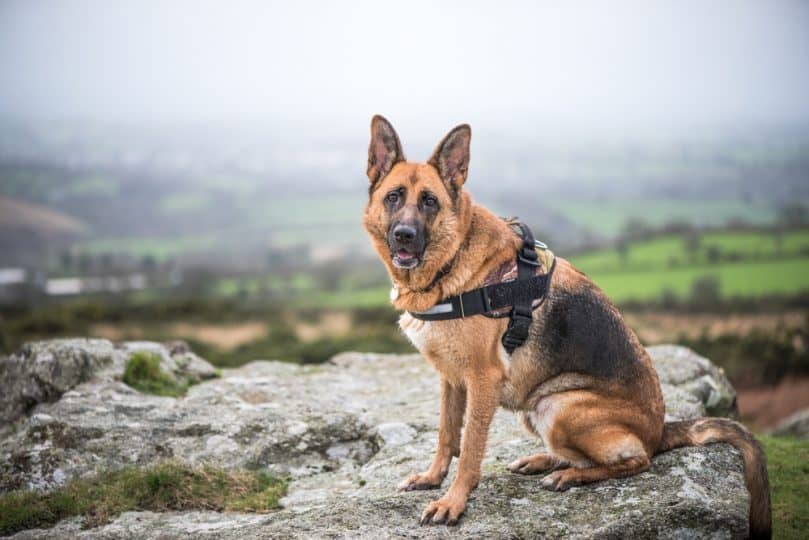
Picking the right size harness for your dog is a little trickier than finding a well-fitting collar. Many brands give recommendations and measurements to help you make the right decision, but your best bet is to bring your German Shepherd to the store and have them try on the harness before you buy it.
The Rabbitgoo Dog Harness is padded and has reflective strips sewn into it for nighttime use. Its breathable fabric makes it perfect for long days spent out in the heat.
For something a little more heavy-duty, there’s the Convert Harness which is designed for hiking. Among other things, it allows you to add bags so your dog can carry their own food and water up the mountain.
No matter what kind of harness your German Shepherd wears, the real success during daily walks is dependent on training. It’s important to establish who is boss. You want to walk your German Shepherd, not the other way around.
To establish an alpha role during walks, it’s important that you:
- Decide in advance whether or not you will let your dog to socialize with other dogs and stick to it. Don’t allow them to visit with one dog but then keep them from the next one.
- Enter and exit the home first. German Shepherds will notice if they are allowed to take the lead.
- Maintain leash control. Don’t allow your German Shepherd to pull you around or lag too far behind. You should dictate the direction you are walking in.
- Give them plenty of time to sniff. German Shepherds have an excellent sense of smell and enjoy sniffing around. Let them do so as long as they’re otherwise behaving.
- Don’t allow your dog to approach strange people or dogs, especially if the other party doesn’t look interested or seems afraid. Always let the other person make the first move to interact.
Here is a great video that will help show you how to keep your dog from pulling on the leash:
Doggy Dan’s 5 Day Course: Day 1 – Pulling on the Leash
How to Train a German Shepherd to Attack
German Shepherd dogs are naturally protective. If you are in any type of real danger, you won’t need a special command to get your German Shepherd to help you.
Because you can rely on their natural protection instinct in the event of an actual emergency, it’s unwise to teach your German Shepherd to attack on command. While members of law enforcement often utilize German Shepherds to subdue criminals, both the human and the canine involved undergo rigorous professional training.
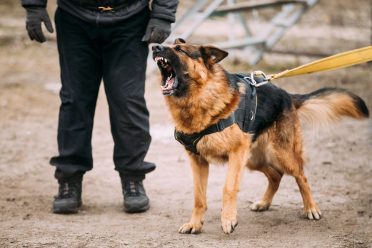
If your German Shepherd dog is simply a pet, there is no reason to train them to attack on command. German Shepherd dogs who are well-trained and well-socialized will be able to differentiate between an actual threat and a perceived threat, whereas aggressive German Shepherds will react even when the situation doesn’t call for it.
Encouraging aggressive behavior in your German Shepherd can have disastrous results, and puts you, your family, your dog, and the public at large at risk.
German Shepherd Training School
While proper training and socialization are important for all breeds of dog, they’re especially important for large guardian breeds such as the German Shepherd. This is why they’re not recommended for first-time dog owners.
If you don’t feel like you’re up to the task, it may be worth it to invest in training lessons for your dog. Failure to properly socialize and train your German Shepherd puts them at risk for a variety of undesirable comportments, such as aggression, shyness, nervousness, and reactionary behavior.

The best way to find a good training school is by word of mouth. Consult your breeder, your veterinarian, and your local German Shepherd Dog club for advice. Don’t be fooled by flashy advertisements and false promises. The best training schools never make guarantees on results.
It’s also important to interview any prospective school and take a tour of their facility. Ask them about their training methods, what kind of training they do, and the various levels and courses available to you. Focus on schools that stress manners and obedience rather than toughness and protection.
Here are a few dog trainers to check out:
German Shepherd Training Books
If you’ve decided to train your German Shepherd dog on your own, you’ll want a little bit of guidance. This is where training books come in. Dog training isn’t always breed-specific, yet there are some things you may need to take into consideration when training your German Shepherd.
Training books geared toward the specific needs of German Shepherds can be an invaluable tool when training your dog. Some good examples are the German Shepherd Owners Guide: From Pup to Pal and the German Shepherd Handbook.
You can consult your breeder, local GSD club, or veterinarian for recommendations.
However, there are also a few good books online that may prove helpful, such as:
- Training Your German Shepherd Dog, by Dan Rice DVM
- German Shepherd Dogs for Dummies, by D. Caroline Coile
- How to Train a German Shepherd: An Essential German Shepherd Training Guide by Austin Gleonard
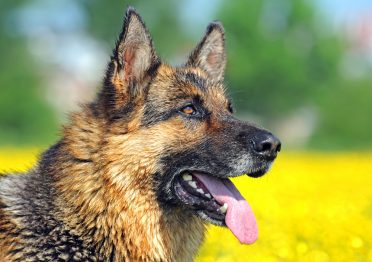
German Shepherd Training Videos
When books aren’t enough, videos can serve as an excellent supplementary learning tool. They can be helpful for visual learners, and it’s great to see the dogs and trainers in action!
A good place to look for German Shepherd Dog training videos is on training school websites. A quick google search will give you tons of videos to peruse, but be careful about the source. Just because someone says they are an expert German Shepherd trainer doesn’t make it true!
Another story is the videos training from the Brain Train For Dogs. This training is clear, provides step-by-step instructions, and comes under a one-time payment.
Additional German Shepherd Training Tips and Tricks
Training your German Shepherd should be fun and educational for both you and your dog.
Here are a couple of tips that will bring you closer to success and help you and your dog form an everlasting bond:
- Keep training sessions short and fun. If your dog dreads the training sessions because they are boring or go on too long, they are less likely to pay attention to you and will be less receptive.
- Use rewards. Treats, toys, and praise are secret weapons for dog training.
- Be a leader, not a boss. Being the “alpha” means being a benevolent leader, not being a dictator. Fear and punishment will only go so far in training your German Shepherd and will seriously undermine your relationship with them.
- Consistency is key. If you are continually changing your methodology or only enforcing the rules part of the time, your German Shepherd will have a hard time understanding what you want. Be consistent and patient as your dog learns.
- Remember that dogs don’t speak our language. Dogs are not born innately knowing what humans want; it’s your job to teach them!
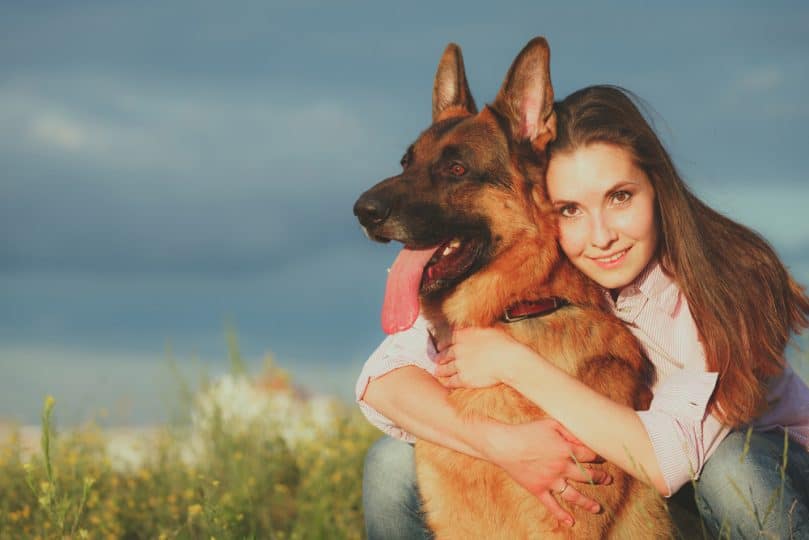
We hope you enjoyed this post on German Shepherd training. These dogs can be a fantastic companion and working animals as long as you’re willing to put in the work it takes to train them properly from a young age.

2 replies on “The Ultimate Guide to German Shepherd Training”
It is helpful,Thanks
It’s our pleasure! Thanks for kind feedback 🙂